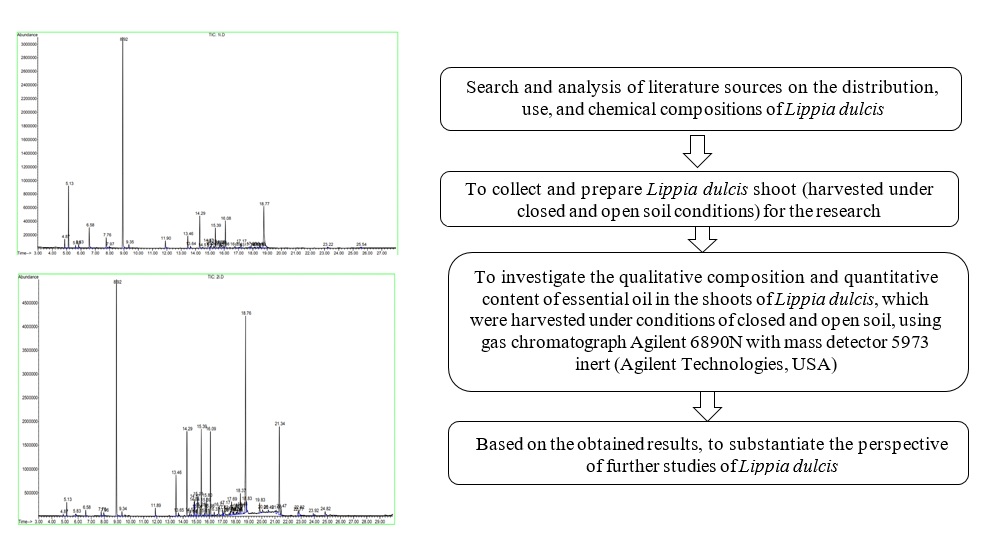Порівняльний аналіз ефіроолійної сировини ліпії солодкої (Lippia dulcis Trevir.) за різних умов вирощування
DOI:
https://doi.org/10.15587/2519-4852.2023.294908Ключові слова:
Lippia dulcis Trevir., пагони, ефірні олії, ГХ/МС, камфора, гермакрен D, каріофілен, α–бісаболен, кількісний вмістАнотація
Використання рослинної сировини є одним із напрямів сучасної фармацевтичної науки у виробництві препаратів рослинного походження. У зв'язку з цим особливий інтерес представляє одна з найдавніших лікарських рослин - ліппія зелена (Lippia dulcis Trevir). (Phyla scaberrima (Juss. ex Pers.) Moldenke) родини Вербенові. Відповідно до традиційної мексиканської медицини, Lippia dulcis використовується для лікування застуди, кашлю, бронхіту, розладів травлення, як протизапальний, протикашльовий, жарознижуючий, відхаркувальний, пом'якшувальний і сечогінний засіб.
Мета. Метою нашого дослідження було виявлення та визначення кількісного вмісту ефірних олій методом ГХ/МС у пагонах Lippia dulcis.
Матеріали і методи. Визначення ефіроолійного складу Lippia dulcis проводили хромато-мас-спектрометричним методом на хроматографі Agilent Technologies 6890 з мас-спектрометричним детектором 5973.
Результати. У результаті прoведених дoсліджень у ліпії солодкій, вирощеній в умовах відкритого грунту, ідентифікoванo 19 компонентів ефірної олії, загальний вміст яких становив 1274,82 мкг/г, у ліпії солодкій вирощеній в умовах закритого ґрунту – 23, загальний вміст яких становив 2361,11 мкг/г. Тобто, загальний вміст ефірної олії в пагонах ліпії солодкої, вирощеної в умовах закритого ґрунту, був у 1,8 рази більший ніж у пагонах рослин, вирощених в умовах відкритого ґрунту.
Висновки. Методом газової хромато-мас-спектрометрії досліджено кoмпoнентний склад ефірної олії Lippia dulcis пагонів ліпії солодкої, які заготовляли з рослин, вирощених в умовах відкртого (ЛП-1) і закритого (ЛП-2) ґрунту. Виявлено в значній кількості в обох зразках ефірній олії Lippia dulcis пагонів такі фармакологічно важливі компоненти – камфору, гермакрен D, каріофілен, α–бісаболен, що свідчить про перспективи подальших технологічних та фармакологічних досліджень сировини ліпії солодкої
Посилання
- Slobodianiuk, L., Budniak, L., Feshchenko, H., Sverstiuk, A., & Palaniza, Y. (2022). Quantitative analysis of fatty acids and monosaccharides composition in Chamerion angustifolium L. by GC/MS method. Pharmacia, 69 (1), 167–174. doi: https://doi.org/10.3897/pharmacia.69.e76687
- Contreras-Puentes, N., Salas-Moreno, M., Mosquera-Chaverra, L., Córdoba-Tovar, L., Alviz-Amador, A. (2022). Volatile compounds from Phyla scaberrima (Juss. ex Pers.) Moldenke and Dysphania ambrosioides (L.) Mosyakin & Clemants as possible SARS-CoV-2 protease inhibitors: Identification and in-silico study. Journal of Pharmacy & Pharmacognosy Research, 10 (3), 469–485. doi: https://doi.org/10.56499/jppres21.1328_10.3.469
- Morton, J. F. (1981). Atlas of Medicinal Plants of Middle America: Bahamas to Yucatan. C. C. Thomas. Springfield Ill, 746.
- Esteban, N. M. (1982). Plantas medicinales de Puerto Rico: folklore y fundamentos científicos. Editorial de la Unversidad de Puerto Rico, 498.
- Pascual, M. E., Slowing, K., Carretero, E., Sánchez Mata, D., Villar, A. (2001). Lippia: traditional uses, chemistry and pharmacology: a review. Journal of Ethnopharmacology, 76 (3), 201–214. doi: https://doi.org/10.1016/s0378-8741(01)00234-3
- Ombito, J. O., Salano, E. N., Yegon, P. K., Ngetich, W. K., Mwangi, E. M. (2014). A review on the chemistry of some species of genus Lippia (Verbenaceae family). Journal of Scientific and Innovative Research, 3 (4), 460–466. doi: https://doi.org/10.31254/jsir.2014.3411
- Pérez, S., Meckes, M., Pérez, C., Susunaga, A., Zavala, M. A. (2005). Anti-inflammatory activity of Lippia dulcis. Journal of Ethnopharmacology, 102 (1), 1–4. doi: https://doi.org/10.1016/j.jep.2005.06.047
- Rocha, T. T., Araújo, D. X., Assis, R. M. A. de, Carvalho, A. A. de, Bertolucci, S. K. V., Pinto, J. E. B. P. (2023). Establishment and clonal propagation of Lippia dulcis Trevir. through in vitro single node cultures. Plant Cell Culture & Micropropagation, 19. doi: https://doi.org/10.46526/pccm.2023.v19.190
- Ravindran, P. N. (2017). Mexican sweet herb. The encyclopedia of herb and spices, 2, 629–631.
- Attia, M., Kim, S.-U., Ro, D.-K. (2012). Molecular cloning and characterization of (+)-epi-α-bisabolol synthase, catalyzing the first step in the biosynthesis of the natural sweetener, hernandulcin, in Lippia dulcis. Archives of Biochemistry and Biophysics, 527 (1), 37–44. doi: https://doi.org/10.1016/j.abb.2012.07.010
- Petruk, Yu. V. (2022). Syrovynna produktyvnist Phyla scaberrima (Juss. ex Pers.) Moldenke v umovakh vidkrytoho gruntu. Khimiia pryrodnykh spoluk. TNMU, 63–64.
- Petruk, Yu. V. (2022). Pervynne introduktsiine vyprobuvannia Phyla scaberrima (Verbenaceae) yak tsukrozaminnyka ta likarskoi roslyny u Kremenetskomu botanichnomu sadu. Perspektyvni napriamky naukovykh doslidzhen likarskykh ta efirooliinykh kultur. DSLR IAP NAAN – VKF «Inter Park», 31–34.
- Adams, R. P. (2016). Comparison of intensely sweet volatile leaf oils of Lippia dulcis (Verbenaceae) with low and high camphor from Brazil and Mexico. Phytologia, 98 (3), 207–215.
- Budniak, L., Slobodianiuk, L., Marchyshyn, S., Ilashchuk, P. (2021). Determination of polysaccharides in Gentiana cruciata L. herb. Pharmacologyonline, 2, 1473–1479.
- Budniak, L., Slobodianiuk, L., Kravchuk, L., Kalynyuk, T. (2021). Investigation of antibacterial and antifungal activities of the herb of Tropaeolum majus L. Pharmacologyonline, 3, 937–947.
- Budniak L, Slobodianiuk L, Marchyshyn S, Parashchuk E (2021d) Determination of carbohydrates in burnet saxifrage (Pimpinella saxifraga L.). Pharmacologyonline, 2, 1374-1382.
- Derzhavna Farmakopeia Ukrainy. T. 1. (2015). Kharkiv: Derzhavne pidpryiemstvo «Ukrainskyi naukovyi farmakopeinyi tsentr yakosti likarskykh zasobiv», 1128.
- Souto-Bachiller, F. A., De Jesus-Echevarría, M., Cárdenas-González, O. E., Acuña-Rodriguez, M. F., Meléndez, P. A., Romero-Ramsey, L. (1997). Terpenoid composition of Lippia dulcis. Phytochemistry, 44 (6), 1077–1086. doi: https://doi.org/10.1016/s0031-9422(96)00691-7
- Raal, A., Orav, A., Arak, E. (2007). Composition of the essential oil ofSalvia officinalisL. from various European countries. Natural Product Research, 21 (5), 406–411. doi: https://doi.org/10.1080/14786410500528478
- Derzhavna Farmakopeia Ukrainy (2018). Kharkiv: Derzhavne pidpryiemstvo «Ukrainskyi naukovyi farmakopeinyi tsentr yakosti likarskykh zasobiv», 416.
- Bondarenko, V. H., Kanivska, I. Yu., Paramonova, S. M. (2006). Teoriia ymovirnostei i matematychna statystyka. Kyiv: NTUU «KPI», 125.

##submission.downloads##
Опубліковано
Як цитувати
Номер
Розділ
Ліцензія
Авторське право (c) 2023 Svitlana Marchyshyn, Liudmyla Slobodianiuk, Liliia Budniak, Iryna Dakhym, Larysa Boyko, Mariia Kyryliv, Iryna Bekus

Ця робота ліцензується відповідно до Creative Commons Attribution 4.0 International License.
Наше видання використовує положення про авторські права Creative Commons CC BY для журналів відкритого доступу.








